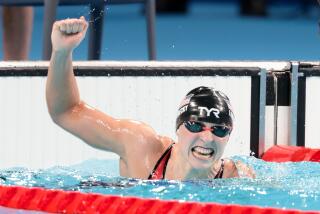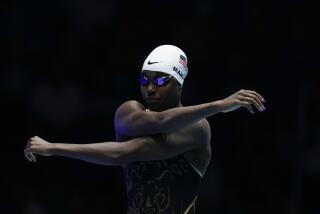For Cox, Water Wasn’t Only Obstacle : Swimming: Surprise visitors, government appeals and rough weather were other problems she had to cope with for the sake of international goodwill.
- Share via
Twenty minutes from the end of her swim across the Beagle Channel Jan. 13, Lynne Cox was joined by a Chilean long-distance swimmer named Alejandro, presenting her with an unspoken dilemma.
“It was nice of him to jump in and support me,” she said, “but I had to slow down so he could keep up, and when I slow down I cool down, and I was already pretty cold.”
Wearing only a light swimsuit, in the 47-degree water her core body temperature, monitored by an internal thermal radio capsule, already had dropped from a normal 98.4 to below the hypothermia level of 95 and would measure 94.5 when she finished the 3-hour, 18-minute effort. Should she swim on at her own pace or, for the sake of international goodwill, which is a major thrust of her swims, should she wait for Alejandro and risk failing to finish?
“I waited,” she said with a sigh. “I slowed my stroke way down. It would have looked really bad if I had just taken off.”
Cox, 33, returned home to Los Alamitos Sunday to discuss events surrounding the swim for the first time. Like her swims in the Bering Strait in 1987 and in Siberia’s Lake Baikal in 1988, there were political difficulties to surmount before she could get her feet wet.
The five-mile-wide Beagle Channel, where Charles Darwin did much of his research on evolution in the 1830s, marks the tense border between Argentina and Chile near the tip of South America. Argentina has a naval base on its side at Ushuaia; Chile has one at Puerto Williams on its side. Sometimes the two have exchanged icy glares at mid-channel. Seldom had either crossed the line--until Cox.
En route to South America before Christmas, she visited the respective embassies in Washington D.C. to make final arrangements. She would start with an escort of Argentine boats for her support team, then everybody would switch to Chilean boats halfway across. Upon Cox’s first look at the Beagle, that plan started to unravel.
She rode out one day on a small Argentine boat which was to pick up a videotape from a Spanish Navy ship, but with the wind howling at 45 knots and a two-to-four foot chop raking the strait like speed bumps, the sailors couldn’t get the tape from one boat to the other.
“We were airborn most of the time, bouncing across those waves,” Cox said. “The sailors were hanging onto anything they could. Dishes were breaking. Seeing how rough it was, I knew it would be extremely dangerous to try to transfer people out there.”
But in trying to arrange to go all the way across in boats from one navy or the other, it was learned that the two Chilean officers who had been told of the original plan were on vacation and had left orders with a subordinate, Lt. Pablo Muller, who had no authority to change them.
Meetings were arranged with Muller, Argentine Navy Capt. Hector Alvarez and Cox.
“Muller didn’t speak English, and our Spanish was about 15 words,” Cox said, adding that she was close to abandoning the project.
But Alvarez, with a last-minute appeal two days before Cox hoped to swim, persuaded Muller to send an inflatable boat across to pick up Cox’s medical team--Prof. William Keatinge and Dr. Penny Neild of London--so they wouldn’t have to transfer. A larger Argentine Navy vessel would hand off escort duty to a Chilean counterpart halfway.
Another team member, Barry Binder, would still have to switch from an Argentine inflatable to a Chilean craft midway, with the luggage. Cox, Binder and Ross Roseman, who accompanied her on a paddleboard, were to continue home through Chile after the swim.
While those arrangements were being thrashed out, Cox had another problem. During that initial, wild trip out on the Argentine boat, she lost her handhold and fell so heavily on her right shoulder that she thought she might have fractured it.
“I couldn’t tell anybody,” she said. “Either I was gonna be able to swim or I wasn’t, and it would have just made everybody concerned. But the next day when I was swimming (in training) I couldn’t get full extension, and it was beginning to show black and blue.”
When she left the water after only an hour, following previous workouts of up to three hours, the Argentine sailors chastized her for quitting early--”like a coach would,” she said.
“I was furious at myself for not knowing what I was getting myself into and then getting myself hurt. The good thing was that I was constantly ‘icing’ it while I was working out, and by the time of the swim it was 100%.”
Meanwhile, Keatinge and Neild toured local medical facilities for possible treatment of hypothermia, cardiac arrest or anything else they thought might go wrong. Sometimes they took Cox along.
During workouts, she refused to hear reports on the water temperature, although admitting, “It took an incredible amount of concentration to get my body into the water and keep it there.”
Somehow, on the day of the swim, all factors came together.
“The organization and coordination on both sides was down to the last detail,” Cox said. “And the captain of the Argentine boat, Jorge Scinurano, said, ‘I’ve never seen a day as perfect as this.’ ”
The air was calm, the channel flat and the surface water temperature as much as nine degrees warmer than it had been in training, although she said, “It didn’t feel any warmer.”
Cox walked into the water off a sandy beach a half-mile west of Ushuaia--and kept walking another 200 yards until it was deep enough to swim. She started stroking at 6:05 a.m.
“The sun was just coming over the mountain tops,” she recalled. “It took me about 10 minutes to start getting into a pace. It seemed to take a long time to get offshore. . . The current, I guess.”
Roseman was alongside, the inflatables behind and the Argentine vessel far off to one side, cautious not to disturb the water with its wake. Cox told Roseman to paddle over and tell them to come closer.
“I wanted them to be part of it,” she said.
The boat came over with the sailors waving flags and shouting encouragewment.
Near the end, the course zigzagged trying to avoid a kelp bed and find a suitable landing spot, but Cox ultimately swam right through the kelp--”Which was a pain, because kelp scratches you pretty badly,”--and stumbled ashore on a rocky beach at Puerto Navarino on Navarino Island.
“It was hard standing up, and, with my feet numb, walking on those rocks was a killer. There were about four houses, a couple of dogs and some people, all excited and jumping up and down. They had been waiting for us.”
She boarded the Chilean vessel for a hot shower, then joined sailors from both countries in a noisy celebration at mid-channel before returning to Chile. Was it worth it?
“It was as tough politically negotiating it as it was jumping into the water,” she said. “And that’s why it’s significant to do it.”


